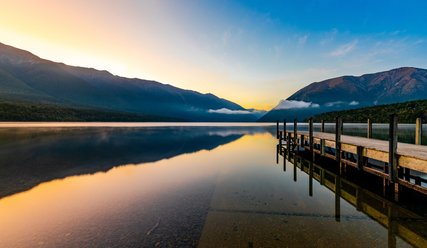Summer Memoir contest winner: Dr Lindsay Quennell
A RELIC AND AN ICECREAM
On the last day of 2023, Lucy O’Hagan emailed me. Would I be interested in the RNZCGP summer memoir competition? Immediately I thought this is right up my alley with my long association with the College going back to 1972 and beyond. If anyone has outlasted me, they may well retort “Good god, is he still alive?!” Yes, I am still going but not as strong as I once was. I am nearing my 86th birthday. Most of my contact with the College was with the GP training programme but not exclusively. I had a false assumption that writing this memoir would be a pushover. Not so!
Let’s go back to 1964. The RNZCGP training program was first recognised as such in 1974, as was the NZ College itself – previously an off shoot of The Royal College of General Practitioners. The GP training programme after much deliberation, additions, alterations including its name, made its first stuttering start in 1964 with Ken William and Ashley Aitken. The College (either the British version or the NZCGP) was much more than the vocational training programme, then known later as the GPTP. The College, in either version, was very involved in giving advice and encouragement to the training programme. It did not truly take over until an act of parliament in 1995 when the new Medical Practitioners Act was passed (the FMTP or was it the GPVTP?). At last it became a specialty.
The father of the original programme is without a doubt Eric Elder, a sole GP in Tuatapere, who with foresight and tenacity initiated the pilot Southland scheme in 1972. The first registrar who started work in 1972 was a Canadian, Ron Estey. He flew into Auckland and, as it seemed to him, New Zealand was closed. It was Christmas/New Year, he finally arrived to start work in the Winton practice, and I and my two partners became GP teachers. We had little idea of what we were doing. Three months later Eric Elder mentored him. No doubt Eric had a much clearer idea how to proceed than we did.
21 years later, John Marwick became the National Director of the Family Medicine Training Programme (FMTP) in 1984 and was solely and directly answerable to the RNZCGP – so perhaps, in effect the College owned the training programme. Much water flowed under the bridge during this period. The program grew in size, complexity and recognition. Along with these significant changes, there were changes to the names of the training programme and its parent body. GPVTP, FMTP and lastly GPTP and the RCGP became the RNZCGP. I managed to cope with it all and in 1993 I was interim National Director briefly when John Marwick stepped down. Who cares now, as most who are not of my vintage would show little much interest in all these comings and goings.
What might be more interesting is my journey from undergraduate days over 64 years, looking back and remembering my time as a member of the Royal College of General Practitioners. In our medical school on the 5th year everyone had to be involved in conducting a public health study of some sort and report on it. I chose a study of the interaction of GPs and alcoholics. I knew little about GPs and even less about alcoholics so there was much scope.
Someone, probably a specialist, gave me a list of suitable GPs with whom I could arrange interviews. I started going to open meetings of AA. I met many alcoholics to find out how they felt about GPs. That is a story in itself. When it came to GPs, I introduced myself to several and interviewed them about alcoholism. I also read a lot about alcohol addiction. I confess that I was unimpressed by many of them, and some were College members. I typed and bound my thesis and presented it to the professor. It was accepted as OK, and that was the end of my interest and involvement with GPs for three years.
After graduating at the end of 1961, I worked a very busy year at Nelson Hospital, then retreated to Dunedin hospital for a second year of rotations. Towards the end of that year, I was unsure about where to head next. Many of my friends seemed to know what specialist they hoped to become, while I felt ‘at sea’.
I made an appointment with the medical school dean seeking advice. I mentioned general practice and his retort was: “with your marks at medical school you could do anything. Why waste your time as a GP?” This dismissive view propelled me into preparing for general practice and I did a third year in hospital rotations: psychiatry, paediatrics, ENT and ophthalmology. I thought I was now fully equipped as a GP and all I needed was a job! I had heard about Dr John O’Hagan in Southland who had a high reputation as a go-getter. He needed a locum for a year as he was off with his family to the UK to pass his Royal College of Physicians exam. I became his locum and as they say, the rest is history. I, my wife and baby were off to work in the Winton practice, welcomed by the senior partner.
It was a hectic year, sharing all the work with Cam Hockin and this included delivering 202 babies in the Winton maternity home. John O’Hagan had been giving anaesthetics at Southand Hospital and, as his locum, I was expected to follow suit. I virtually taught myself anaesthetics. I had been aware of a Dr ‘Tubby’ Neill in Dunedin who regularly visited his patients who were in hospital. I saw an opportunity, so after giving anaesthetics, I began visiting patients from the Winton practice unofficially (although the hospital provided me with a list). This gave me an insight into how these patients were coping and what was going to happen when they went home. It also gave me a greater understanding of the relationships and interactions between GPs and other specialists. I also got to know several GPs who were College members in Invercargill. They were an interesting, enthusiastic and respected bunch and through them I became interested in joining the RCGP (New Zealand branch). I also attended College meetings in Dunedin, and was informed that I could become a member by presenting a sort of thesis, if it was up to scratch.
In 1969, my wife and I and our two daughters under five, decided to spread our wings. We organised a locum in Winton for a year and we were off to work in the UK doing locums. During the long sea voyage, I had decided to use some of that free time to write up my experience and ideas about the role of the GP in the hospital. I found that there was a more relaxed atmosphere in Southland Hospital where GPs were respected and where I was welcomed. Regular meetings were held at the hospital, involving specialists and GPs. Looking back, I can see how important John O’Hagan was, as by then, he had established himself as full-time physician and later as tutor (when registrars, host practitioners and other interested GPs were involved in the weekly registrar day release program).
So here I was enthusiastically writing up my ‘thesis’ full of ideas. When my year in the UK finished (and there is another full story here) we returned to Winton. I tidied up my report and presented it to the College to gain my membership. It went missing! I had no copy! There was an apology and humble request by the College that I could be examined instead. I was confident and I passed. I increasingly realised that there was much more to know about general practice. Communication skills for instance. Balint’s book was titled “Six Minutes for the patient”. I wondered!
I left the practice at the end 1977 (yet another story). As luck would have it, Dr Pat Hertnon of the well-known Otumoetai Centre, was appointed as Coordinator for six months in 1977 to do the groundwork to establish the new FMTP. Along with his very considerable drive, skill and charm, he visited all major hospitals and house surgeons and most relevant organisations. He took time to drop by and was aware that I showed some interest in moving to the large group practice in Levin. When I moved there, he persuaded me to investigate reviving the previously lapsed GP training program in and around Palmerston North.
By 1979, with the support of several senior College members, I initiated this new program 2/10th appointment, with two registrars and two GP teachers to start. Over the next 16 years, when I was appointed Central Region director, 5/10ths, there was a considerable expansion with registrars appointed and a team of part-time teachers, all of whom were active and enthusiastic College members. The team comprised GPs from Hawkes Bay, Feilding, Palmerston North, Waikanae, Levin, Wanganui and New Plymouth.
Over this period, we developed a great and supportive cooperative team of teachers and very satisfied registrars. After the Levin Medical Centre, I moved to the Albert St Medical Centre in Palmerston North. Somehow the split role of part-time GP and regional director seemed to work and the six regional directors also worked cooperatively. With John Marwick, National Director of RNZCGP, we all worked well with enthusiasm and ongoing professional development. I was able to engage more often with College activity, as Wellington was only a drive away. Together, David Chatterton and I also established a Manawatu subfaculty in Palmerston North and environs.
It would probably be boring to list all my involvement with the many and varied College activities over 17 years. A couple of examples: Chair of the RNZCGP Wellington Faculty in 1984-1986, RNZCGP Member, Panel of Examiners in 1980-1984. I realise that there were many other stalwarts like me. In 1995, I was appointed as visiting Fellow by the Australian training program for six months. Obviously my credentials and participation in the Royal New Zealand College of General Practitioners stood me in good stead. A year later, at age 58, it was time we moved again, and my wife and I emigrated to live and work in Melbourne, where I was appointed as the full-time medical educator in the Victorian GP training program of the Royal Australian College of General Practitioners.
Now I have been happily retired for 16 years and given little thought about the distant past. I read both histories of the College and its training programme and thought this be an important but rather dull task. Quite the opposite. It has brought so many rich and positive memories. So many names of colleagues I knew, liked and respected. I can see them clearly in my mind’s eye and hear them speak. Many are now deceased.
When I met one of the senior College members at the WONCA conference in 1980, he seemed somewhat resentful that we were staying in a hotel in the French Quarter of New Orleans. “Quennell, if you fell down a sewer, you would come up with an ice-cream in your hand!”
I know I have lived such a charmed life. I know the ice-cream is still there! My wife Faye and I have been married for 63 years and she has been very much my partner and companion in our great adventure.
I now have the full circle drawn. My first experience of general practice was in Winton. Lucy’s father, John, was the person that opened the opportunity when he contacted me to do his locum. He became my friend and mentor until he died many years ago. I have kept contact with Lucy from the age of six. She blossomed and has been a great contributor to our College. My thanks for the opportunity to contribute my memoir. It has given me great pleasure and the flooding back of memory has only occurred because I heard about the competition.


